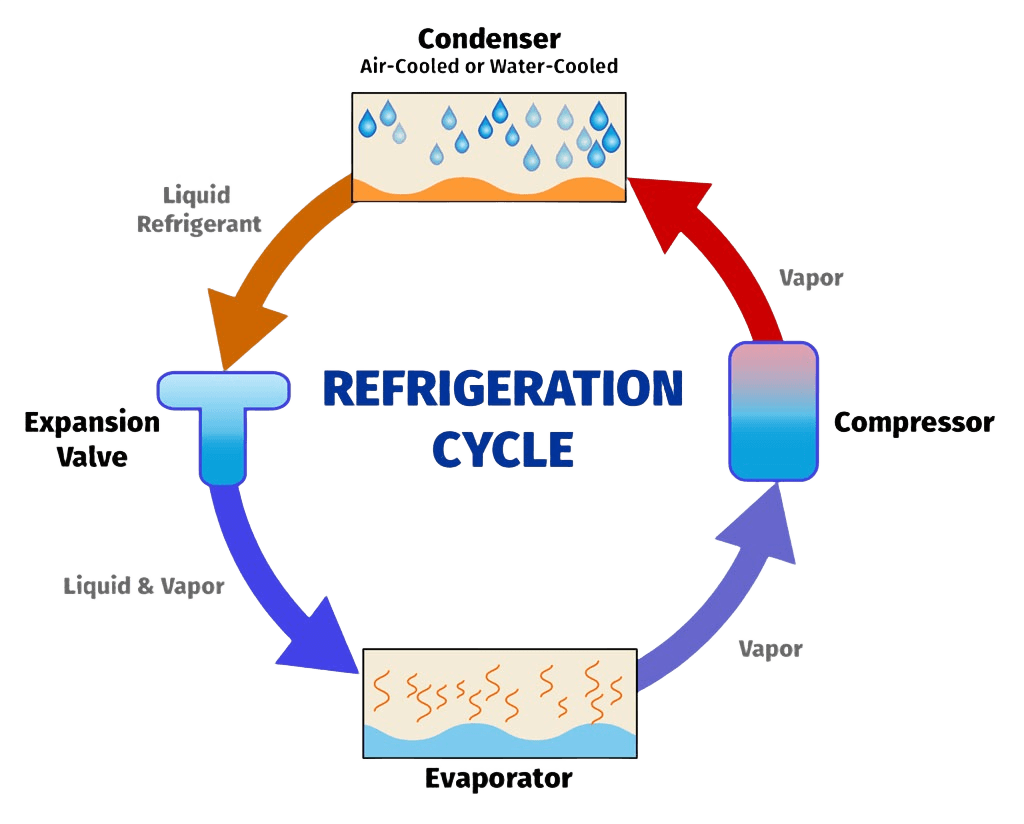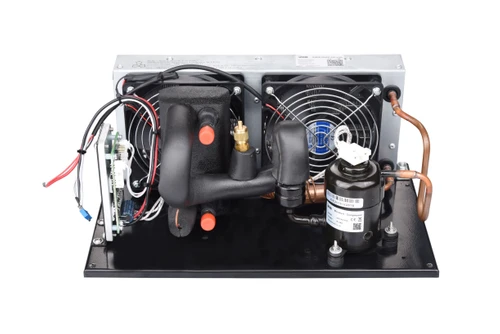Introduction

"RIGID is a miniature refrigerated compressor innovation leader in China. We keep looking for novel solutions in compact and portable cooling systems. We capture new technologies in mobile and compact cooling systems."
Refrigeration is an essential technology that underpins modern living, preserving food and providing comfort in our homes and workplaces. Understanding the refrigeration cycle components is crucial for grasping how these systems operate efficiently. This knowledge not only empowers users to make informed decisions but also aids in troubleshooting when issues arise.
The Science Behind Refrigeration Cycles
At its core, the refrigeration cycle is a fascinating interplay of physics and engineering that allows heat to be transferred from one area to another, creating a cooling effect. The process involves the four major refrigeration cycle components: the compressor, condenser, expansion valve, and evaporator. Each component plays a pivotal role in ensuring that the entire system operates smoothly and effectively.
Key Components of Cooling Systems
The key components of cooling systems work harmoniously to maintain optimal temperatures in various applications, from household refrigerators to industrial chillers. By understanding what are the 4 main components of refrigeration system PDF, users can appreciate how each part contributes to overall efficiency. This knowledge is vital for anyone looking to maximize performance or minimize energy consumption.
Importance of Understanding Refrigeration
Understanding refrigeration isn't just for technicians; it's beneficial for everyday users as well. By knowing what are the 5 steps of the refrigeration cycle, individuals can recognize when their systems may need maintenance or upgrades. Moreover, with innovations like those from RIGID leading advancements in mini compressors and micro cooling systems, staying informed helps consumers make smart choices in a rapidly evolving market.
What is the Refrigeration Cycle?

The refrigeration cycle is a fundamental process that allows us to cool and preserve food, maintain comfortable indoor environments, and support various industrial applications. Understanding this cycle involves exploring its key components, which work together to transfer heat efficiently. By grasping the intricacies of the refrigeration cycle components, we can appreciate their significance in our daily lives.
Overview of the Refrigeration Process
At its core, the refrigeration cycle is a thermodynamic process that moves heat from one area to another, effectively cooling a designated space or substance. The process begins when a refrigerant absorbs heat from the environment in the evaporator, causing it to change from liquid to gas. This gas is then compressed by the compressor, increasing its pressure and temperature before passing through the condenser where it releases heat and condenses back into a liquid state.
The refrigeration cycle consists of four major steps: evaporation, compression, condensation, and expansion. Each step plays an essential role in ensuring efficient cooling and maintaining desired temperatures in various applications. Understanding what are the 5 steps of the refrigeration cycle helps demystify how these systems function seamlessly in our homes and workplaces.
The Role of Heat Exchange
Heat exchange is pivotal in facilitating energy transfer within refrigeration systems. As refrigerants circulate through different components, they absorb heat during evaporation and release it during condensation; this continuous exchange maintains temperature control effectively. The efficiency of these processes relies heavily on understanding what are the 4 main components of refrigeration system PDF as they dictate how well heat can be transferred between substances.
In essence, heat exchangers play crucial roles within both evaporators and condensers by maximizing contact surface area for optimal thermal transfer. This ensures that refrigerants can absorb sufficient heat for effective cooling while simultaneously releasing it when necessary—keeping your refrigerator running smoothly! Without proper management of these exchanges, refrigeration systems would struggle to maintain their intended performance levels.
Importance in Daily Life
The importance of understanding the refrigeration cycle cannot be overstated; it impacts everything from food preservation to climate control in buildings. Refrigeration technology has revolutionized how we store perishables and manage indoor temperatures—making life more comfortable and convenient for millions worldwide! Additionally, recognizing what are the 4 parts of a refrigerator can enhance consumer knowledge about energy efficiency and maintenance practices.
Moreover, advancements in micro-cooling technologies have led to innovative solutions that cater specifically to diverse needs across industries—from medical storage solutions requiring precise temperature control to compact air conditioning units designed for small spaces. RIGID's contributions exemplify this trend as they pioneer mini compressors tailored for mobile applications while ensuring uncompromising quality standards throughout their product lines.
As we continue embracing new technologies within refrigeration systems—such as those developed by RIGID—we pave the way for smarter designs that prioritize user experience without sacrificing performance or sustainability goals!
What are the 4 Major Refrigeration Cycle Components?

In any refrigeration system, understanding the four major refrigeration cycle components is crucial for grasping how cooling processes work. These components—compressor, condenser, expansion valve, and evaporator—play distinct roles in facilitating the continuous cycle of heat exchange that keeps our food fresh and our environments comfortable. By diving into each component's function, we can better appreciate their importance in both everyday appliances and larger cooling systems.
Exploring the Compressor Function
The compressor is often referred to as the heart of the refrigeration cycle. It takes low-pressure refrigerant gas and compresses it into a high-pressure gas, increasing its temperature in the process. This critical step helps initiate the cycle by propelling the refrigerant through other components; without a functioning compressor, there would be no effective cooling.
When considering what are the 4 major refrigeration cycle components, it's essential to highlight that a well-functioning compressor not only boosts efficiency but also impacts energy consumption directly. Modern innovations have led to more compact designs with improved energy efficiency ratings, making them an integral part of any advanced cooling system. Companies like RIGID are at the forefront of this innovation with their mini compressors designed for various applications.
Understanding the Condenser Role
Following compression, we encounter the condenser—the component responsible for releasing heat absorbed from inside your refrigerator or air conditioning unit to the outside environment. The high-pressure gas from the compressor enters this component and cools down as it passes through coils or fins; during this process, it transforms back into a liquid state. This phase change is vital because it allows for efficient heat removal from your living space.
Understanding what are the 4 main components of refrigeration systems requires acknowledging how crucial effective condensation is for overall performance. If condensation does not occur properly due to dirt build-up or mechanical failure, it can lead to inefficient operation and increased energy costs. RIGID’s advancements in micro cooling systems ensure that condensers operate at peak performance even in compact applications.
The Significance of the Expansion Valve
Next up is our unsung hero—the expansion valve—which regulates refrigerant flow into the evaporator while simultaneously reducing its pressure significantly. This drop in pressure allows refrigerants to expand and cool before entering another critical phase of heat absorption within your refrigerator or air conditioning unit. It's fascinating how such a small part plays a significant role in controlling both temperature and pressure within an entire refrigeration system!
When exploring what are the 5 steps of refrigeration cycles, recognizing how important proper expansion valve functionality is cannot be overstated; without it, you wouldn’t achieve optimal cooling results! Moreover, RIGID’s custom solutions include innovative expansion valve designs tailored specifically for unique micro-cooling needs—demonstrating their commitment to enhancing efficiency across all components.
The Evaporator's Function
Finally, we arrive at one of our favorite parts—the evaporator! This component absorbs heat from its surroundings by allowing low-pressure liquid refrigerant to evaporate inside coils or fins as warm air passes over them; thus providing much-needed cooling inside refrigerators and air conditioning units alike! As this transformation occurs from liquid back to gas form again completes one full loop of what we refer to as ‘the refrigeration cycle.’
Understanding what are the 4 parts of a refrigerator involves recognizing how vital an efficient evaporator is for maintaining optimal temperatures within these appliances—after all, it's where all that delicious coldness comes from! With RIGID leading innovations in miniaturized designs suitable even for tight spaces without sacrificing performance quality ensures that every aspect—from evaporation downwards—is accounted for when creating effective solutions tailored specifically towards customer needs.
What are the 5 Steps of the Refrigeration Cycle?

Understanding the five steps of the refrigeration cycle is crucial to grasping how refrigeration cycle components work together to provide effective cooling. Each step plays a vital role in ensuring that heat is absorbed from one area and released in another, creating a continuous loop that keeps your refrigerator running smoothly. Let’s break down these steps to see how they contribute to the overall process.
Step-by-Step Breakdown of the Cycle
The refrigeration cycle begins with the compressor, which compresses refrigerant gas, raising its pressure and temperature. This high-pressure gas then flows into the condenser, where it releases heat and transforms into a liquid state. Next, this liquid refrigerant passes through an expansion valve, reducing its pressure and allowing it to evaporate in the evaporator coil, absorbing heat from its surroundings and completing what we often refer to as “the 5 steps of the refrigeration cycle.”
Each of these stages corresponds directly with what are considered the four major refrigeration cycle components: compressor, condenser, expansion valve, and evaporator. Understanding this step-by-step breakdown not only clarifies how these components function individually but also highlights their interconnected roles within the system.
Heat Absorption and Release
Heat absorption occurs primarily in the evaporator coil where low-pressure refrigerant absorbs heat from inside your refrigerator or freezer compartment. This process cools down your food while simultaneously converting the refrigerant back into a gas form as it absorbs energy from its environment. Afterward, this gas travels back to the compressor for re-compression—a critical moment that demonstrates just how integral each part is in facilitating efficient heat release across various stages of what we call “the refrigeration cycle.”
Simultaneously, when discussing heat release within this context—especially during condensation—it’s essential to understand that this phase allows for excess thermal energy extracted during evaporation to be expelled outside your appliance. This entire interaction between absorption and release ensures that temperatures remain low inside your fridge while maintaining optimal performance levels across all four parts of a refrigerator.
The Continuous Loop Explained
The beauty of understanding what are the 5 steps of the refrigeration cycle lies in recognizing that it's a continuous loop rather than a linear process; once one step completes its function, it seamlessly leads into another without interruption! The refrigerant flows through each component repeatedly—compressor → condenser → expansion valve → evaporator—ensuring consistent cooling throughout its operation.
This cyclical nature not only maximizes efficiency but also minimizes energy consumption by allowing for constant temperature regulation within refrigerated spaces. As you dive deeper into understanding these processes alongside RIGID's innovative contributions to mini compressors and micro cooling systems, you’ll appreciate how modern technology enhances our everyday experiences with refrigerators—and why knowing about those four main components is key!
RIGID's Contributions to Refrigeration Technology

RIGID has established itself as a leader in the mini compressor innovation space, particularly in China. Their commitment to capturing new technologies has revolutionized mobile and compact cooling systems, making them a key player in the field. By focusing on superior design and uncompromising quality, RIGID is not just another name; they are pioneers in the micro cooling industry.
Innovations in Mini Compressors
When discussing refrigeration cycle components, RIGID stands out with its innovative mini compressors that redefine efficiency and performance. These mini compressors are designed to operate seamlessly within various refrigeration systems, making them essential for applications requiring compact solutions. By enhancing energy efficiency and reducing noise levels, RIGID's innovations allow users to enjoy optimal cooling without compromise.
The advancements made by RIGID also address common questions like What are the 4 major refrigeration cycle components? The mini compressors play a vital role here by serving as the heart of the system, compressing refrigerants effectively while minimizing space requirements. This innovation is crucial for modern applications that prioritize both performance and space-saving designs.
Applications of Micro Cooling Systems
RIGID’s micro cooling systems have found their way into numerous applications across different industries. Whether it's for medical devices needing precise temperature control or automotive systems requiring efficient air conditioning, these systems showcase versatility at its best. Understanding What are the 5 steps of the refrigeration cycle? helps highlight how these micro cooling systems function efficiently within diverse settings.
In addition to their practical applications, RIGID's solutions contribute significantly to answering queries about What are the 4 parts of a refrigerator? Their technology integrates seamlessly with existing components like condensers and evaporators, ensuring smooth operation across various platforms. The adaptability of these micro cooling systems allows them to meet unique client needs while maintaining high efficiency.
Custom Solutions for Unique Needs
One of RIGID’s standout features is its ability to provide custom solutions tailored specifically for clients' unique requirements. This approach not only enhances user satisfaction but also addresses critical aspects of refrigeration technology that many companies overlook. By working closely with customers, RIGID ensures that all aspects related to refrigeration cycle components are optimized based on individual specifications.
Their dedication extends beyond standard offerings; they focus on understanding what clients truly need from their refrigeration systems—whether it’s energy savings or enhanced performance under specific conditions. This commitment positions them as a go-to resource for businesses seeking answers such as What are the 4 main components of refrigeration system PDF? Customization remains at the forefront of their business model, allowing clients to boost competitiveness through tailored solutions.
What are the 4 Parts of a Refrigerator?

When we think about refrigerators, we often overlook the intricate interplay of their various parts. Each component plays a vital role in ensuring that the refrigeration cycle operates smoothly and efficiently. Understanding these four main parts can illuminate how refrigeration systems keep our food fresh and our drinks cool.
Identifying Key Components
The four primary components of any refrigerator are the compressor, condenser, expansion valve, and evaporator. Each of these refrigeration cycle components has a distinct function that contributes to the overall efficiency of the cooling process. Recognizing these parts helps demystify how refrigerators work and why they are essential in our daily lives.
Interplay Between Parts
The relationship between these four parts is crucial for effective operation. The compressor pumps refrigerant through the system, while the condenser dissipates heat from the refrigerant to cool it down before it enters the expansion valve, where its pressure drops significantly. Finally, as refrigerant flows into the evaporator, it absorbs heat from inside the refrigerator, completing what are known as “the 5 steps of the refrigeration cycle,” which maintains a consistent temperature within your appliance.
Importance for Efficient Operation
Understanding what are the 4 parts of a refrigerator is essential for users who want to maintain their appliances effectively. Each component's performance directly impacts energy consumption and cooling efficiency; if one part fails or works suboptimally, it can lead to increased energy costs or spoilage of food items. Thus, having knowledge about these refrigeration cycle components not only enhances user experience but also promotes sustainability by encouraging proper maintenance practices.
Conclusion
In summary, understanding the refrigeration cycle components is essential for grasping how cooling systems operate effectively. The refrigeration cycle revolves around four major components: the compressor, condenser, expansion valve, and evaporator. By recognizing how these parts interact within the system, users can appreciate the intricacies of what makes their refrigerators and air conditioning units work.
Recap: Major Components of Refrigeration
To recap, the four main components of refrigeration systems include the compressor, which pressurizes refrigerant; the condenser, where heat is released; the expansion valve that regulates refrigerant flow; and finally, the evaporator that absorbs heat from its surroundings. Understanding these critical elements helps in troubleshooting and maintaining efficient operation. A solid grasp of these refrigeration cycle components can lead to improved energy efficiency and longevity of appliances.
Why Understanding is Essential for Users
Understanding what are the 5 steps of the refrigeration cycle enhances user awareness about energy consumption and appliance performance. When users know how each component functions within this continuous loop—from compression to evaporation—they can make informed decisions regarding maintenance or upgrades. This knowledge not only fosters better care for their appliances but also empowers them to choose products that align with their needs.
Future Trends in Refrigeration Technology
As we look ahead, future trends in refrigeration technology promise exciting advancements in efficiency and sustainability. Innovations like RIGID's mini compressors are leading a shift towards more compact cooling solutions that cater to modern demands without compromising on quality or performance. With an increasing focus on eco-friendly designs and custom solutions tailored to specific requirements, understanding refrigeration cycle components will be crucial for consumers eager to embrace these new technologies.